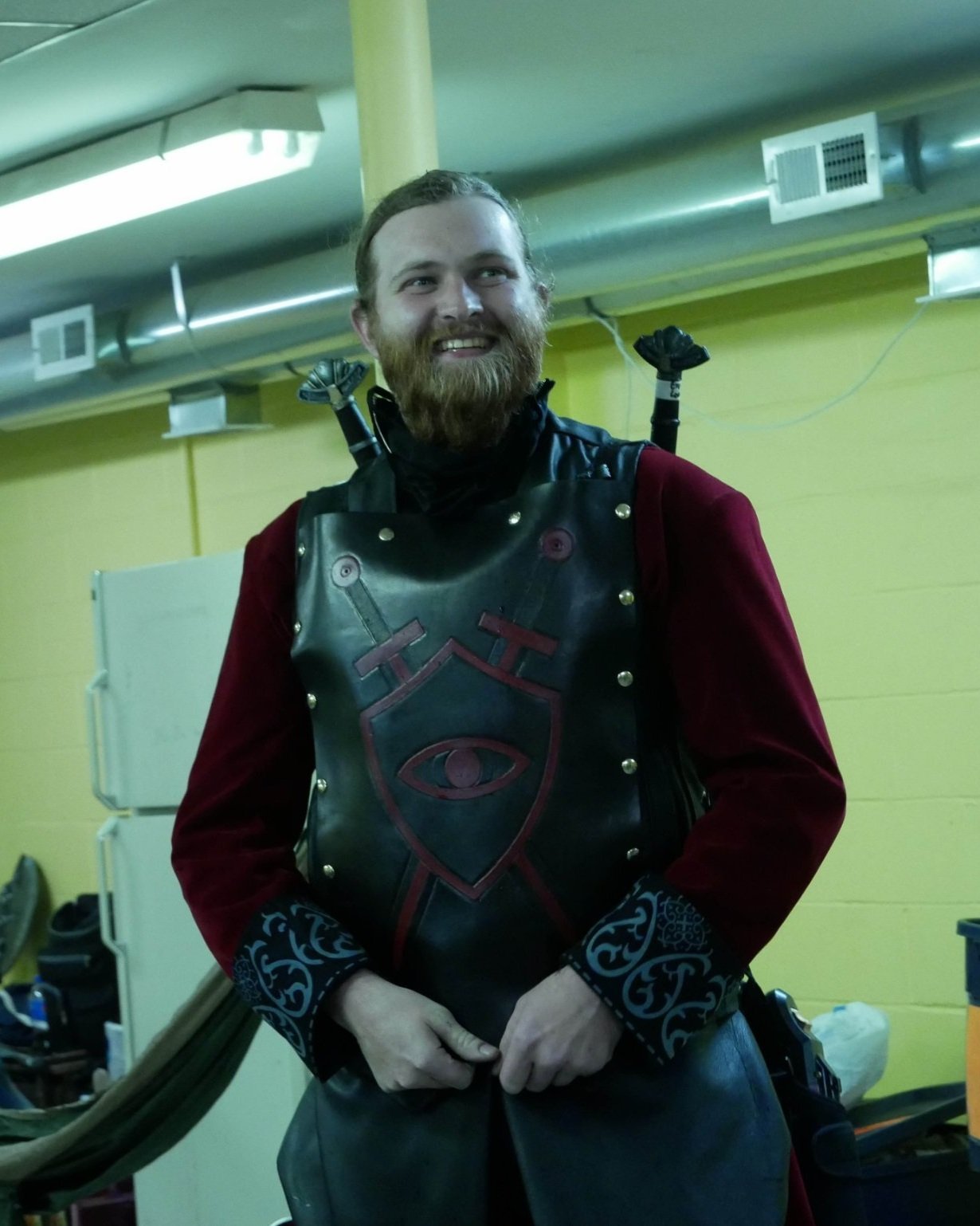SHIELDS AND ARMOR
ARMOR
Armor is clothing that defends its wearer from attack by absorbing hits to their vitals. In the World Beyond the Fall, it does this by passively decreasing the amount of damage its wearer receives. Furthermore, those with the Armor Expertise skill are able to angle their bodies when struck to allow their armor to take the worst of a hit (see Armor Expertise skill below).
What constitutes an Armor is more art than science, although Armor must cover at least the front and back torso (minimum of 50% of both). At the wearer's discretion, it may also cover more than that but torso coverage is the minimum. A leather duster is considered to be armor. The same applies to a hard leather vest or leather jacket. Naturally, a breastplate or a mail hauberk counts as armor. By themselves, gloves are not armor, nor are boots or helmets or the like.
Also of importance is the safety of an Armor prop. The heat of battle and the armor wearer’s movement will require resilient and tough armor physreps.
Armor should not possess sharp edges or points, for the safety of the players and their weaponry. It should also be able to withstand out-of-game physical strikes. If it breaks and exposes dangerous edges or materials, it must be removed from the game area as soon as possible.
Examples of Heavy armor, Ultraheavy Armor, and Body armor.
Armor Types
There are three main types of Armor: Body Armor, Heavy Armor, and Ultraheavy Armor. These are defined by the material they appear to be made of, their weight, and their flexibility. Normally, the Dodge defense cannot be used while wearing Armor. On the other hand, certain defenses rely on their user wearing Armor or a specific quality of Armor.
Take note that you may only wear and benefit from one Armor at a time.
BODY ARMOR
This is the most commonly worn armor in the World Beyond the Fall due to its wide range of movement, its breathability, and its ease of creation. such as a leather vest, leather jacket, or a duster. The Armored Dodge skill allows an individual to use the Dodge defense even while wearing Body Armor.
Examples:
Leather Vest/Jacket
Thin Chain Hauberk (Aluminum, Steel wire, or similar weight)
Padded Gambeson
Corset
HEAVY ARMOR
Usually made of rigid, relatively flexible materials. Having multiple layers of body armor may be counted as a single Heavy Armor prop, upon the Game Staff's discretion.
Wearing Heavy Armor has additional benefits if you have the Faith in Steel skill of the Warrior Class. Furthermore, many Armor Augments that increase defense or toughness are restricted to Heavy and Ultra Heavy Armor only
Examples:
Hard Leather Breastplate
Heavy Chain Hauberk
Motorcycle Jacket
Padded Gambeson + Thin Chain
Leather Vest + Duster
ULTRAHEAVY ARMOR
Armor that is made of real or faux metal. Alternatively, it involves significant amounts of metal or a similar material in their construction. They tend to look solid and sturdy but can be more uncomfortable to wear for long periods of time. Besides the prop requirements, weight is the main difference between Heavy and Ultraheavy armor. Characters usually adorn these armors with long coats, dusters, serapes, or similar pieces of garment to make them match the aesthetics of the setting.
This has additional benefits if you have the Faith in Steel skill of the Warrior Class. Furthermore, many Armor Augments that increase defense or toughness are restricted to Heavy and Ultra Heavy Armor only.
Examples:
Steel Breastplate
Brigandine or Scale Coat
Bulletproof/Plated Vest
Padded Gambeson + Heavy Chain
Scale Coat
This Templar found a Book!
Plated Vest
CLOTHING
Normally, this does not count as armor. This represents various pieces of clothing and dress that a Character may use to adorn themselves. While basic clothing has no mechanical benefit, the Advanced and Superior versions of clothing may be Augmented, similar to armor. These Augmented items have abilities that are more useful for those who favor mobility over toughness or spellcasters who want to enhance their magical power.
Wearing Augmented Clothing (as opposed to normal or basic Clothing) prevents a Character from benefiting from any other worn Armor or Augments. The reverse is also the same. However, it is technically not armor, especially for the purposes of the Dodge defense.
Armor Benefits
The main mechanical advantages of wearing Armor are twofold. They are tied to increasing their wearer’s resistance to injury and are activated by the Refit Armor action. — this is a 10 minute out-of-combat process of donning armor and/or maintaining it. This must be done away from fighting and similarly stressful situations, similar to Resting, and it can be done while taking the Rest Action.
As per usual, you may only wear and benefit from one Armor at a time.
Armored HP — +2 bonus to Maximum HP.
Reflecting an increased resistance to injury, refitting Armor allows an armor wearer to use their Armored HP value instead of the normal maximum HP value. The Armored HP value is your maximum HP +2. Certain Skills and Armor Augments may increase this.
Taking off Armor -- A character's current HP is unchanged when they take off their armor, unless it was beyond their unarmored maximum HP, in which case it reverts to the unarmored maximum HP value.
Aegis Points
Requirement: Armor Expertise Skill
Aegis Points are a special resource that one may be granted by having the Armor Expertise Skill while wearing armor. With this Skill, a character may “Refit” their armor -- this process takes at least 10 minutes, can be done while resting and requires the simulation of repairing/donning one’s armor.
At the end of this process, the armor wearer loses all Aegis they currently have and then they gain their maximum Aegis (starting at one, without any other Skills or Augments). You may never have more than 5 Aegis at a time.
Using Aegis: Invoke “Aegis” and expend an Aegis Point to negate the damage or the effect of all attacks received within the last second. You must stop forward motion and/or take a step away from your attacker. You are unable to use Aegis to defend yourself if any of those attacks are Ambush attacks (blows that come from behind and hit your back torso) or Master attacks.
Other Benefits — Certain Skills and Weaver Augments may add more functionality and bonuses to wearing armor. For example, the Heatproof Weave Augment grants armor wearers the Resist Radiation skill and can negate Flame attacks. The Full Coverage skill allows armor wearers additional Aegis when wearing armor on both of their arms/hands and on both of their legs/feet.
SHIELDS
Shields in BTF are defined as hand-held or arm-strapped defensive items. Examples of these are bucklers, round shields, targes, and similar items. For the purposes of item creation, they are Weaponry Items despite their purely defensive qualities.
BTF allows both homemade shields (often made of bread trays or plywood) and most commercial latex shields. A shield should have padded edges, and be free of any sharp or pointed objects that may damage weapons or injure fellow players.
Shields that are easily breakable, or are made of dangerous materials will also not be allowed to enter the game. It is for this reason that all shields are subject to the same inspection rules as weapons.
Some pre-fall items lend well to being a shield
Shield Sizes
For out-of-game reasons of balance and simplicity, Player Character shields in BTF have a size-limitation of 32 inches diameter for round shields. For non-round shields, there can be no dimension exceeding 32 inches, with regards to shield height, width, diagonal length or any other dimension except thickness.
The in-game reason for this limited shield size is that several monsters, attacks, and horrors are able to easily penetrate shields. Thus, the denizens of the World Beyond the Fall have relegated their shields to smaller versions that maintain their own physical maneuverability to dodge such assaults.
Policy and Safety Violations involving Shields
No Shield Bashing: For the purposes of safety, “Shield Bashing” or striking someone with a Shield is not allowed and is considered a safety violation.
Not a Free Hand: A hand or arm that is using a shield is considered to be “wielding it” for the purposes of free hands and weapons. That said, a shield that leaves its wearer’s hand free does NOT allow for that wearer to use that hand for various in-game skills that require a free hand. Furthermore, they may not wield a weapon with that hand.
No Turtling: Crouching or being prone while using a Shield is called “Turtling”, as it blocks legal targets from attack and exposes illegal targets to attack. Moreover, many monsters have a special attack called a “Prone Attack” that bypasses such defenses and inflicts major damage to prone targets.
Benefits of Using a Shield
Shield Use: Weapon strikes that hit a shield are not counted as hitting the character. This means that you may manually and legally maneuver a shield to intercept weapon strikes from hitting you without expending Focus or other resources.
Block defense (usually requires Stalwart Defense skill): This is the potent defense but is usable only when wielding a shield. Invoke “Block!”and expend 1 Focus to negate all melee and ranged attacks that just hit you in the last second. You need to be wielding a shield of basic quality or better to use this. The following conditions prevent you from invoking the Block defense:
You are not wielding a Shield
Any of the attacks come from behind you and hit your back torso (aka Ambush attacks)
Any of the attacks are Master attacks and are invoked as such.
Other Bonuses: Certain Skills and Weaponry Augments may add more functionality and bonuses to wielding a Shield. For example, the Grav Barrier Augment allows you to defend others with your shield while the Furious Rebuke skill allows you to knockback an enemy after you use the Block defense.














